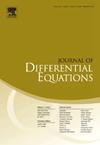从非线性Schrödinger方程到相互作用粒子系统
IF 2.3
2区 数学
Q1 MATHEMATICS
引用次数: 0
摘要
研究了一类非线性Schrödinger方程- ε2Δuε+uε=uεp,uε>0inRn, ε→0时解的极限行为,其中p为Sobolev次临界。假设这些解有无穷多个峰。导出了极限峰点之间的相互作用形式。这是通过首先描述uε的主阶项,并通过反向Lyapunov-Schmidt约简方法提供非常精确的误差估计,然后以极限方式从约简方程中提取信息来实现的。本文章由计算机程序翻译,如有差异,请以英文原文为准。
From nonlinear Schrödinger equation to interacting particle system
We study the limiting behavior of solutions to nonlinear Schrödinger equations as , where p is Sobolev subcritical. These solutions are assumed to have infinitely many peaks. We derive the interaction form between the limiting peak points. This is achieved by first describing the main order term of and providing a very precise estimate on the error by the reverse Lyapunov-Schmidt reduction method, and then extracting information from the reduction equation in a limiting way.
求助全文
通过发布文献求助,成功后即可免费获取论文全文。
去求助
来源期刊
CiteScore
4.40
自引率
8.30%
发文量
543
审稿时长
9 months
期刊介绍:
The Journal of Differential Equations is concerned with the theory and the application of differential equations. The articles published are addressed not only to mathematicians but also to those engineers, physicists, and other scientists for whom differential equations are valuable research tools.
Research Areas Include:
• Mathematical control theory
• Ordinary differential equations
• Partial differential equations
• Stochastic differential equations
• Topological dynamics
• Related topics

 求助内容:
求助内容: 应助结果提醒方式:
应助结果提醒方式:


